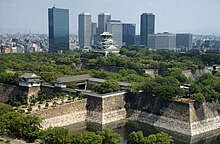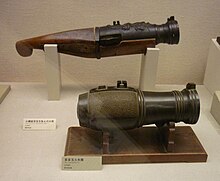Sengoku time

The Sengoku period ( Japanese 戦 国 時代 sengoku-jidai , dt. Time of the warring countries ) is one of the most eventful ages in Japanese history . The beginning of the Sengoku period is dated around 1477 (Ōnin war) to the end of the Muromachi period . The Sengoku period passed into the era of the three unified empires ( Azuchi Momoyama period ) in 1573 .
Historical classification
The Ashikaga shogunate had steadily declined in power during the Muromachi period . With the Ōnin War ( 1467 - 77 ), the Ashikaga shogunate lost its importance and the country the last of a central government authority. In the next 100 years or so, referred to in the history books as the Sengoku period ( 戦 国 時代 , Sengoku-jidai , Age of Warring States ), new men fought for rule over the archipelago.
Under the rule of the Ashikaga, the provinces were ruled by local rulers who, at least formally, were still Shugo , i.e. appointed provincial governors. With the end of central statehood, a new type of feudal lord appeared, the Sengoku daimyo . He no longer legitimized himself through the appointment of a central government, but through land ownership and military power. Japan was fragmented into countless territories, the rulers of which waged wars against one another in frequently changing alliances.
The fragmentation was overcome with military force by three generals, Oda Nobunaga , Toyotomi Hideyoshi and Tokugawa Ieyasu . With the unification of Japan and the establishment of a new shogunate ended period of Warring States early 17th century.
The Warring States
With the end of the Ashikaga shogunate, an estimated 200 territories with autonomous rulers emerged. About thirty of them were economically and militarily powerful enough to play a role in the hegemonic struggles. In the middle of the 16th century, Mōri Motonari , Hōjō Ujitsuna , Imagawa Yoshimoto , Oda Nobunaga , Takeda Shingen and Uesugi Kenshin had emerged as the main opponents. Akechi Mitsuhide , Hashiba Hideyoshi, and Tokugawa Ieyasu later fought for power.
Takeda Shingen and Uesugi Kenshin fought violently. Four battles at Kawanakajima were inconclusive . Imagawa Yoshimoto marched against Oda Nobunaga in 1560. Although his army numbered about 20,000 men, the Oda (who led only 3,000 warriors into battle) attacked his main camp and killed Yoshimoto in the Battle of Okehazama . In 1568 Oda Nobunaga succeeded in conquering Kyoto , using Ashikaga Yoshiaki as a puppet shogun and using this legitimation to strive for the conquest of all of Japan. Oda formed an alliance with Tokugawa Ieyasu , a former general of Imagawa Yoshimoto . He then marched against the most important Buddhist monasteries in the country, as their monk soldiers, the Sōhei , had supported his enemies. The attack on Enryaku-ji Monastery in 1571 , which he surrounded and set on fire, is cited as an example of his cruelty and severity . He also showed no mercy in the struggles against the sects of Osaka . In 1573 he ousted Ashikaga Yoshiaki and was thus ruler of Japan. With this act, Japanese historical scholarship also speaks of the entry into the Azuchi Momoyama period , in which only a handful of large remaining Sengoku daimyo , organized in a western and an eastern alliance, faced each other with the respective main fortresses of Azuchi. jō and Momoyama-jō .

In 1575 , Oda Nobunaga won the Battle of Nagashino over the armies of the nearby Takeda army, which consisted mainly of cavalry. This victory was based not least on the first-time use of firearms on a larger scale. In the following time he prepared himself to fight his remaining enemies, between 1576 and 1579 he built the Azuchi fortress, which later gave part of its name to the Azuchi-Momoyama period . In 1582, Oda Nobunaga and his eldest son were ambushed and forced to commit suicide by Akechi Mitsuhide , one of his most important confidants and military leaders.
Toyotomi Hideyoshi, who at that time was fighting as a general for Nobunaga in the west of the country, returned, killed the traitor Akechi Mitsuhide and assumed rule.
With Toyotomi Hideyoshi, the second of the three unifiers emerged. He had started his career as a simple soldier in Nobunaga's army and after some power struggles in 1585 he was the most powerful man in the country. He confirmed Oda Nobunaga's alliances with the Uesugi and the Tokugawa and faced the remaining great daimyo of the country to fight. In 1590 he defeated them and completed Japan's unification. Hideyoshi divided the country into about 200 provinces, transferred the rule to daimyo and secured their loyalty. He secured his rule through personal disposal over productive provinces, and he surrounded himself only with daimyo who were loyal to him. Furthermore, he had himself confirmed as regent by the emperor. Despite everything, the system wasn't completely stable. In 1591 he ordered an invasion of Korea . It is still unclear today whether he seriously believed he could conquer Korea and China , or whether he wanted to get the unemployed warriors out of the country, who represented a constant potential for conflict. The invasion was unsuccessful due to Chinese military might and ended after Hideyoshi's death in 1598 .
Before he died in 1598, he commissioned a council of five daimyo, which also included Tokugawa Ieyasu, with the reign of his heir, who was still underage. Immediately after Toyotomi Hideyoshi's death, the struggle for power began. Tokugawa Ieyasu was able to assert himself and assure the support of many daimyo. In 1600 he destroyed the contingent of his remaining enemies in the Battle of Sekigahara . With this victory Japan was finally united and the Tokugawa would rule Japan for over two and a half centuries.
Social impact
Despite the troubled conditions, the final phase of the Sengoku period was a time of significant developments for Japan. Oda Nobunaga reformed the administration of the villages, land surveying and tax collection. A reform and standardization of weights and measures as well as a liberation of trade laid the foundation for the rise of the merchants ( chōnin ), which would later be formative for the Edo period .
Toyotomi Hideyoshi established the basis for the Baku-Han system of the Tokugawa shoguns with the system of the daimyo as provincial lords, who were obliged to be loyalty to the regent . He continued Oda Nobunaga's reforms, re-partitioning Japan and introducing a tax in the form of rice. His most important reform approach, however, was the introduction of estates. He in particular, who had served himself up from peasant to warlord, forced people to be either peasants or warriors ( samurai ).
This reform step turned out to be difficult because huge armies of peasants had been raised during the long war years of the Sengoku era. Until the Onin War, the Bushi , Japan’s warrior elite, had fought alone . The peasants were also armed for the mass battles of the following years. After Toyotomi Hideyoshi's social reform , they had to be disarmed again in so-called sword hunts ( katana-gari ).
This division of society formed the basis for the later social model of the Edo period with its four estates. Tokugawa Ieyasu eventually perfected the approaches of his two predecessors and installed a political system of remarkable stability.
Web links
Individual evidence
- ↑ http://wiki.samurai-archives.com/index.php?title=Battle_of_Okehazama from November 26, 2014
- ↑ http://wiki.samurai-archives.com/index.php?title=Oda_Nobunaga
- ↑ http://wiki.samurai-archives.com/index.php?title=Azuchi-Momoyama_Period
- ↑ http://wiki.samurai-archives.com/index.php?title=Toyotomi_Hideyoshi from November 26, 2014



